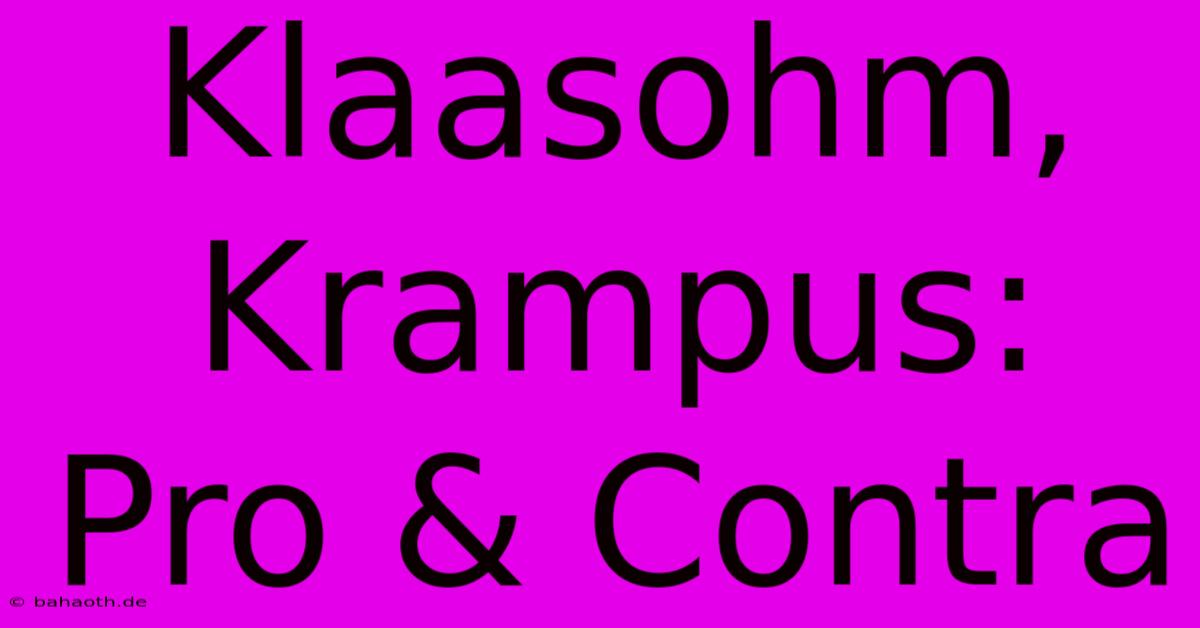Klaasohm, Krampus: Pro & Contra

Discover more detailed and exciting information on our website. Click the link below to start your adventure: Visit My Website. Don't miss out!
Table of Contents
Klaasohm vs. Krampus: Pro & Contra
The holiday season brings forth a variety of traditions, some heartwarming and others… well, let's just say a little terrifying. Two figures who embody this duality are Klaasohm and Krampus. While both are associated with the Christmas season and often act as a counterpoint to the jolly St. Nicholas, they offer vastly different approaches to the holiday spirit (or lack thereof). Let's delve into the pros and cons of each.
Klaasohm: The Gentle Counterpart
Klaasohm, a figure less widely known than Krampus, is often portrayed as a gentler, more benevolent counterpart to St. Nicholas. He's sometimes depicted as a helper, assisting St. Nicholas in his gift-giving duties. This nuanced role sets him apart from the more fearsome Krampus.
Pros of Klaasohm:
- Positive Reinforcement: Klaasohm's presence encourages good behavior, but through positive reinforcement rather than fear. This gentler approach is considered more suitable for younger children.
- Teamwork and Cooperation: The depiction of Klaasohm assisting St. Nicholas highlights teamwork and cooperation, valuable lessons for children.
- Less Frightening: His generally benign nature makes him a more comfortable figure for children who might be scared by Krampus's menacing appearance.
Cons of Klaasohm:
- Lack of Distinctiveness: Because Klaasohm is less widely known, he lacks the strong cultural significance and established folklore that Krampus possesses. This makes him less readily recognizable and potentially less impactful.
- Limited Mythology: The limited mythology surrounding Klaasohm leaves less room for creative storytelling and artistic interpretations compared to Krampus.
- Less Engaging Narrative: His role as a helper, while positive, can be less engaging than the more complex and dramatic narrative associated with Krampus.
Krampus: The Fearsome Tradition
Krampus, a horned, demonic-looking creature, embodies the darker side of the Christmas season. His role is to punish naughty children, often with birch branches or by carrying them away in his sack. This stark contrast to St. Nicholas creates a powerful, albeit frightening, message.
Pros of Krampus:
- Strong Cultural Significance: Krampus boasts a rich history and strong cultural significance in Alpine regions, with centuries of tradition and folklore behind him. This contributes to his enduring popularity and recognition.
- Engaging Narrative: The fearsome nature of Krampus provides a compelling and dramatic narrative, making him a more engaging figure for storytelling and artistic expression.
- Effective Discipline: While potentially frightening, Krampus serves as a powerful reminder of the importance of good behavior, using fear as a disciplinary tool (though arguably a harsh one).
Cons of Krampus:
- Potentially Traumatizing: The fearsome appearance and threatening behavior of Krampus can be traumatizing for young children, creating unnecessary anxiety during the holiday season.
- Outdated Disciplinary Methods: The methods of punishment associated with Krampus are outdated and arguably cruel, promoting fear rather than understanding and positive reinforcement.
- Negative Connotations: The association of Krampus with fear and punishment can overshadow the positive aspects of the holiday season.
Conclusion: A Matter of Perspective
Ultimately, the choice between embracing Klaasohm or Krampus, or even both, comes down to personal preference and cultural context. While Klaasohm offers a gentler, more positive approach, Krampus's dramatic presence and rich cultural history remain undeniably captivating. The key is to consider the age and sensitivity of the children involved and to choose the approach that best suits your family's values and traditions. Both figures, however, offer valuable insights into the complexities and contrasts inherent in the celebration of Christmas.

Thank you for visiting our website wich cover about Klaasohm, Krampus: Pro & Contra. We hope the information provided has been useful to you. Feel free to contact us if you have any questions or need further assistance. See you next time and dont miss to bookmark.
Also read the following articles
| Article Title | Date |
|---|---|
| Kalifornien Seebeben Loest Tsunami Warnung Aus | Dec 06, 2024 |
| Stabile Us Aktienmaerkte | Dec 06, 2024 |
| Eudr Inkrafttreten Spaeter | Dec 06, 2024 |
| Starkes Beben Tsunami Gefahr Kalifornien | Dec 06, 2024 |
| Kalifornien Erdbeben Keine Tsunami Gefahr Mehr | Dec 06, 2024 |
